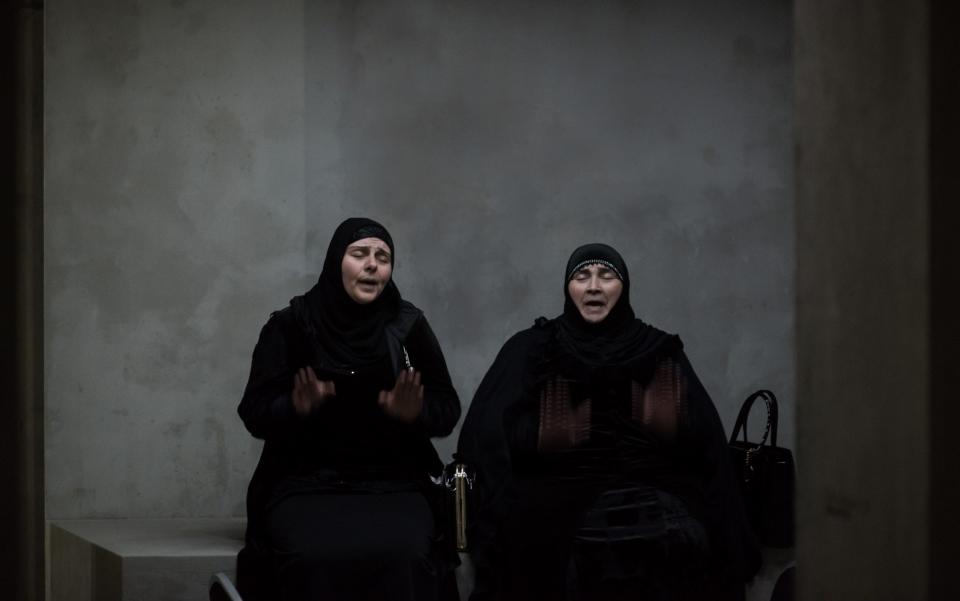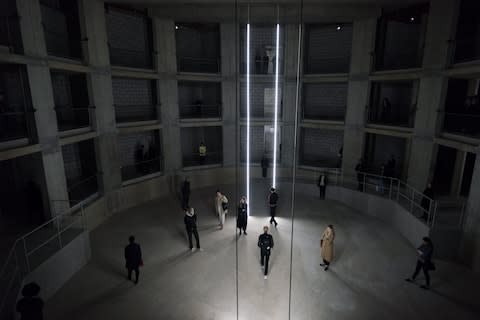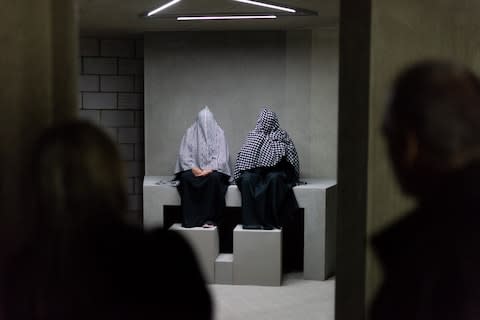Taryn Simon, review: a wailing, primal cacophony with the flavour of a surreal dream

What does it feel like to cross the threshold to the afterlife? The ancients told elaborate stories about what happens when we die, including, in the case of the Greeks, a ferryman called Charon who shipped souls into Hades across the River Styx.
The American artist Taryn Simon has a rather different vision. According to her latest artwork, An Occupation of Loss – first staged at New York’s Armory two years ago, and now reprised in London under the aegis of the arts organisation Artangel – one of the entrances to the underworld is located off an ugly atrium to a complex of luxury flats at the northeast corner of Islington Green.
Having descended through this portal myself, I can report that getting to the afterlife involves strolling through an area resembling a concrete carpark. On this evidence, at least, we have little to fear from the end that will meet us all – except prosaic architecture.
Beneath this limbo-like stretch, though, the architecture is anything but dull. After scouting possible venues in the capital for four years, Simon selected a cavernous, three-storied, subterranean auditorium, built as a theatre in the style of Shakespeare’s Globe by the developers responsible for the flats above, but never used.

She chose it for its echoing acoustic properties, rather than any resemblance to the underworld. Still, appearing like the stacked circles of Dante’s Inferno, and with a distinctly catacomb-like atmosphere, it’s brilliantly appropriate for Simon’s work, which invites us to encounter groups of “professional mourners”, i.e. people paid to grieve publicly at funerals and other rituals on behalf of families or communities, from all over the world.
Once the audience has assembled (on the night I attended, I spotted the actress Cate Blanchett among the crowd), a sombre, expectant hush falls, before a note struck on a “toaca”, a wooden Romanian percussion instrument, announces that the performance has begun.
A beat slowly builds, and the mourners – around 20 in total – emerge one by one or in twos and threes, passing through pairs of tall, thin strip lights, suspended from the ceiling, like otherworldly gates from a sci-fi movie. The procession is slow, stately – introducing us to the players in Simon’s drama – an opening ceremony not for the Olympics but some festival of the dead.
Eventually, the mourners take up position in small chambers and chapel-like nooks, the drumming stops, and the time-honoured keening of different cultures begins simultaneously.
How to describe this discordant sound? A groaning, wailing, primal cacophony – underscored by haunting refrains from an accordion played by an Ecuadorian man wearing sunglasses in the gloom, lending the whole affair the flavour of a surreal dream.
Instinctively, the audience understands that they are free to explore and listen to individual performers up close. There are Chinese mourners and Ghanaian dirge-singers, Yezidis and Russians, and Venezuelan representatives of the Native American Wayuu people, whose laments, apparently, safeguard the soul’s passage to the Milky Way.

There are lots of wizened women wearing black, including an Albanian, with a lace chemise and silver crucifix, whose face seems lined with Sibyl-like wisdom. Another beats the walls, beside a folded newspaper and a loaf of bread. Women, it turns out, have enacted grief on behalf of others for millennia, especially in cultures that deem it unmanly to cry: as I approached a pair of women from Azerbaijan, an attendant emerged from the shadows to block my path: “These women mourn in the absence of men,” she whispered, uttering the only words I heard during the entire performance. That was me told.
What is the effect of this half-hour of weeping and gnashing of teeth? Here’s the curious thing: surrounded by such a surfeit of emotion, I was expecting a satisfying cathartic release; that by the end, I too would be sobbing for the tragedy that is mortality. But that didn’t happen.
Slowly, it dawns that Simon intends a cool effect. Pay close attention to the structure of the piece, and you will notice that, at its heart, there is a great yawning absence: for all the lamentation, there is no object of grief, no body on a bier. Moreover, we know that the grief of the mourners, while culturally authentic, is simultaneously staged and inauthentic – after all, they are performing, producing crocodile tears for cash.
The presentation of the mourners is alienating, too. Simon, here working with performance for the first time, having earned an enviable reputation as a photographer-cum-conceptual artist, belongs to a long line of modern artists interested in “typology”, i.e. classifying groups of diverse artefacts or cultures.
That is certainly her approach here: in their austere alcoves, the mourners are like specimens in a living anthropological textbook, exotica for our inspection, even titillation. They are before us, but also, somehow, remote: they do their thing almost automatically, performing as though we were not there. The effect is disquieting – a little like, if you were being uncharitable, a kind of dead-eyed masquerade.
But I left wondering if the work was subtler than that.
It is often said that we live in a superficial age and behave according to codes and customs rather than innate biological imperatives. Well, here is a thoughtful, even profound artwork that reflects on both observations, raising interesting questions about “authentic” behaviour, with a terrifying nothingness at its core.
The ancients grieved for heroes. We, in Simon’s vision, lament a void. When the keening stopped and the mourners departed, the audience were left alone and in silence, shuffling uncertainly through Simon’s empty netherworld. The street seemed a long way up.
Islington Green, London N1. Until April 28; information: artangel.org.uk

 Yahoo Sport
Yahoo Sport 





































